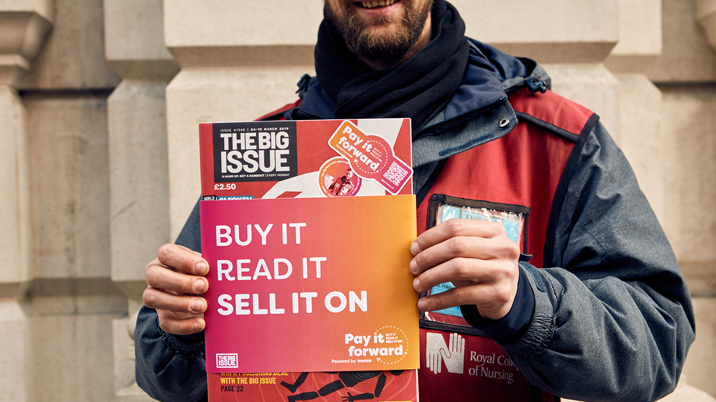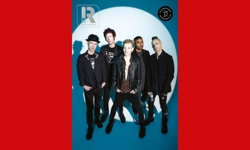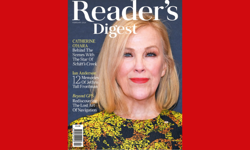
The Big Issue, launched 30 years ago by John Bird and Gordon Roddick, is a social business providing an important income for the street vendors who sell it. And, when it comes to publishing and editorial strategy, it’s also a bit of a conundrum.
“There’s how we present The Big Issue, then there’s how the public see it,” the title’s UK Editor Paul McNamee observes. “Regardless of how I’ve changed the editorial, the look, the team, the awards we have won over the years, people to an extent, still think of it as ‘the homeless magazine’.”
On the other hand, the significant brand awareness the magazine enjoys across Britain and beyond is, of course, a powerful and positive thing. But it is important, McNamee says, that people don’t by The Big Issue as “a pity purchase”.
Many people have a real connection with their local Big Issue vendors. “But I want them to value the product as much as they value the interaction they have with the person they are buying it from,” he explains.
“To achieve this, content has to drive as many sales as does the social benefit of buying from a homeless person. And I’ve worked incredibly hard to make this clear.”

The fact that The Big Issue is not owned by a big media company, works to no particular owner-driven agenda, and has the broadest imaginable readership – along with its social mission, of course – are fundamental shapers for its publishing and editorial strategy.
Who reads The Big Issue?
“Rather than vertical silos, I look at a horizontal line and on that line – regardless of age, social class, ethnicity or any of those things – the content we produce needs to say interesting things for people with a social justice fire than burns in them who want to know about the world and make that world better,” McNamee continues.
“It’s not catering for a demographic but a mindset. So, whether you are a 13 year-old kid just becoming alive to politics or injustice around you or an 80 year-old who still has the desire to change the world to be a better place, you want the title to address that.
“So, we ask ourselves how to produce content that speaks to that want rather than a particular person. That’s the starting point. And as we build content around it, the focus is on making it witty, engaging and fearless, not preachy.”
He adds: “We are nimble. We are an outsider. We also sell a lot of issues a week. If someone comes to us and says, ‘I have a problem with a landlord’, we will look into it – as we will if there’s a whole set of people who face a particular problem. We will advocate and, when necessary go further – to parliament, even, where John Bird is now a peer.”
It’s not catering for a demographic but a mindset.
Cover stars
Covers, guest editors and – most recently – digital transformation are important tools in maximising The Big Issue’s sales.
“Covers are a very big issue for vendors, and we have a rule – if a cover doesn’t work at 20 feet, it doesn’t work,” he says. “A cover doesn’t have to be prize-winning every time, it just has to be the right cover for us.”
And invariably, when the cover star isn’t StreetCat Bob – a stray ginger cat whose attachment to vendor James Bowen, a homeless street musician and recovering drug addict, has spawned a series of books and films – ‘the right cover’ reflects the staggering access that brand awareness plus social mission can achieve.
“We try to present a platform to the people we interview to give us something they’re not necessarily going to give somewhere else,” McNamee explains. “That’s why the ‘Letter To My Younger Self’ feature works so well – it’s a reveal.”
Guest editors are also successful in generating striking content that drives both sales and publicity – Armando Iannucci’s suggestion to feature Malcolm Tucker, the foul-mouthed spin doctor from The Thick of It TV series, in conversation with Alan Partridge in the edition he edited being a case in point.
In another edition, guest edited by comic book writer Mark Millar and themed around heroes, Mark Hamill, who played Luke Skywalker in Star Wars, interviewed his heroes: Ray and Dave Davies of The Kinks.
Digital transformation, however, is a more recent sales driver – in fact, one forced on The Big Issue by Covid-19.
“I’d realised for a time we weren’t doing enough good work online and got away with it by saying ‘We’re a street mag making money through street sales’,” McNamee readily admits.
Then, one press day in March 2020, advance warning of the imminent national lockdown – which in a matter of hours, would remove from the street both the vendors and purchases on which the title’s 78,000 weekly UK sales depend and also its buyers – led to a major pivot, with the initial planning done over a weekend.
“We decided for the first lockdown, which we initially thought would be three months, we’d become a subscription magazine – something we’d not done before, as we didn’t want to get in between the buyers and vendors. We went into shops for the first time. And we built an app so we could sell a digital edition properly for the first time,” he says.
The months since may have been dominated by firefighting, but there has also been time for a strategic review of “what digital is for” which resulted in the recent expansion of The Big Issue’s digital team.
“When street sales dry, you need to be ready for the next time and that means building the publishing output so we can start looking at different means of revenue,” McNamee concludes.
“Like everything, it’s all about growing sales to get more money out to the vendors.”

You can hear Paul McNamee being interviewed by Ciar Byrne on a recent episode of The InPublishing Podcast, which was sponsored by Acorn Web Offset, the Yorkshire-based specialist A5 and A4 magazine printer.
This article was first published in InPublishing magazine. If you would like to be added to the free mailing list, please register here.












